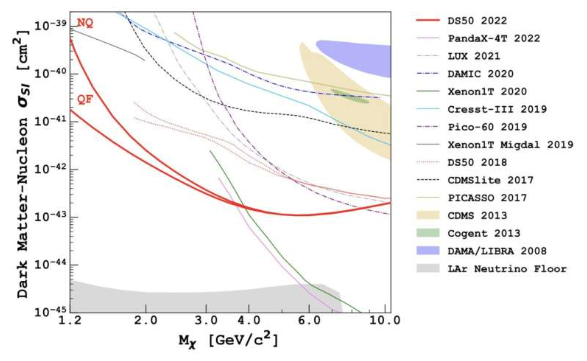The Global Argon Dark Matter Collaboration (GADMC) was formed to unite the global community interested in dark-matter searches using liquid argon (LAr) target. GADMC is currently building inside the LNGS Hall-C DarkSide-20k, a two-phase LAr detector with a 50 tonnes active volume, 1000 times more than its predecessor DarkSide-50. The experiment is expected to begin operation in 2027 and is designed to either detect WIMP dark matter or reach a 90% CL exclusion sensitivity to WIMP-nucleon cross sections of 6.3x10-48 cm2 at the mass of 1TeV/c2.
DarkSide-50 experiment and dual-phase TPC technique

Dual-phase time projection chambers using noble liquids are detectors able to measure both the scintillation light induced by particle interacting in the active noble liquid target and also the ionization charges produced in the event. The detector is equipped with light detectors able to detect the prompt scintillation light. The ionization electrons, guided by an electric field, drift towards the surface of the liquid where a thin layer of gas is present. A stronger electric field is created on the surface of the liquid, enabling the extraction and subsequent acceleration of these ionization electrons in the gas that in turn generate a delayed light signal used to reconstruct the 3-dimensional position of the event.

The DarkSide-50 TPC was deployed within a borated liquid scintillator-based neutron veto, which is in turn inside a water Cherenkov muon veto, allowing a very effective active background suppression. In 2015 the DarkSide collaboration pioneered the use of ultra low-radioactivity Argon from Underground sources (UAr) as the ideal target for future experiments. The physics run using the UAr target lasted from 2015 to 2018. Using this data the DarkSide-50 collaboration published its final search on high mass WIMP dark matter candidates in 2018, with a 90% CL exclusion limit of 3.78x10-44 cm2 at the mass of 1TeV/c2. More recently, in 2022, it updated its earlier results on low mass dark matter candidates using the full data set acquired by the experiment, setting a world best 90% CL exclusion for DM-nucleon cross section of 6x10-43 cm2 for a WIMP mass of 3 GeV/c2.
DarkSide-20k experiment

The DarkSide-20k experiment consists of an inner detector housed within a sealed stainless steel vessel and an outer muon veto all deployed within a ProtoDUNE-style membrane cryostat. It is currently under construction in the LNGS Hall-C and is foreseen to begin operations in 2027 and will either detect WIMP dark matter or exclude a large fraction of favored WIMP parameter space.

The UAr volume is separated by the sealed stainless steel vessel from the 600 t of liquid Argon from the Atmosphere (AAr) filling the entire ProtoDUNE cryostat volume. The outer veto detector consists of 32 PDUs suspended in the AAr buffer and is used to suppress cosmic muon induced backgrounds.
Selected recent publications
- P. Agnes et al., "Search for low-mass dark matter WIMPs with 12 ton-day exposure of DarkSide-50", Phys. Rev. D 107 (2023), 063001.
- P. Agnes et al., "Search for Dark-Matter–Nucleon Interactions via Migdal Effect with DarkSide-50", Phys. Rev. Lett. 130 (2023), 101001.
- P. Agnes et al., "Search for Dark Matter Particle Interactions with Electron Final States with DarkSide-50", Phys.Rev. Lett. 130 (2023), 101002.
- P. Agnes et al., "DarkSide-50 532-day dark matter search with low-radioactivity argon", Phys. Rev. D 98 (2018), 102006.
- P. Agnes et al., "Results from the first use of low radioactivity argon in a dark matter search", Phys. Rev. D, 93 (2016) 081101(R).
- P. Agnes et al., "Separating 39Ar from 40Ar by cryogenic distillation with Aria for dark-matter searches", Eur.Phys.J.C 81 (2021) 4, 359.
- C. E. Aalseth et al., "Design and Construction of a New Detector to Measure Ultra-Low Radioactive-Isotope Contamination of Argon", JINST 15 P02024.
Spokesperson
This email address is being protected from spambots. You need JavaScript enabled to view it. (GSSI & Princeton University)
Deputy spokesperson
This email address is being protected from spambots. You need JavaScript enabled to view it. (Royal Holloway University of London)
Official website
http://darkside.lngs.infn.it/


